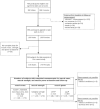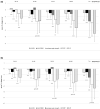Longitudinal changes in muscle power compared to muscle strength and mass
- PMID: 33657752
- PMCID: PMC8020018
Longitudinal changes in muscle power compared to muscle strength and mass
Abstract
Objectives: The study reports longitudinal changes in grip strength, muscle mass and muscle power of lower extremities. The aim is to identify early muscular changes to improve the diagnosis and treatment of sarcopenia.
Methods: Grip strength was measured by hand dynamometer, muscle mass by dual-energy X-ray absorptiometry and muscle power by performing a chair rise test and two-leg jumps (2LJP) on the Leonardo Mechanograph®. Longitudinal changes were analysed using paired t-tests by age group and sex. Differences between groups in terms of the annual change were tested by Analysis of Variance and the Dunnett's test. Comparisons between the variables were performed using one sample t-tests.
Results: Six-year changes were determined in 318 randomly selected healthy participants aged 20-90 years from Berlin. 2LJP declined significantly earlier in 20-39 years old women (-3.70 W/kg) and men (-5.97 W/kg, both p<0.001). This is an absolute annual decline of -0.46 W/kg in females and -0.75 W/kg in males. In the oldest age group, 2LJP showed the highest absolute annual loss with -0.99 W/kg in women and -0.88 W/kg in men. 2LJP was significantly different compared to all variables of muscle mass and strength (p<0.01).
Conclusions: The results underline the importance of assessing muscle power using 2LJP during aging.
Keywords: Aging; Longitudinal; Mechanography; Muscle Power; Sarcopenia.
Conflict of interest statement
The authors of the study received grants from The Danish Research Foundation during the conduct of the study.
Figures



Similar articles
-
The impact of muscle function, muscle mass and sarcopenia on independent ageing in very old Swedish men.BMC Geriatr. 2019 May 29;19(1):153. doi: 10.1186/s12877-019-1142-y. BMC Geriatr. 2019. PMID: 31142271 Free PMC article.
-
Age-related changes in skeletal muscle mass among community-dwelling Japanese: a 12-year longitudinal study.Geriatr Gerontol Int. 2014 Feb;14 Suppl 1:85-92. doi: 10.1111/ggi.12219. Geriatr Gerontol Int. 2014. PMID: 24450565
-
Reproducibility of jumping mechanography and traditional measures of physical and muscle function in older adults.Osteoporos Int. 2015 Feb;26(2):819-25. doi: 10.1007/s00198-014-2983-z. Epub 2014 Dec 9. Osteoporos Int. 2015. PMID: 25488806
-
Jump test performance and sarcopenia status in men and women, 55 to 75 years of age.J Geriatr Phys Ther. 2014 Apr-Jun;37(2):76-82. doi: 10.1519/JPT.0b013e3182a51b11. J Geriatr Phys Ther. 2014. PMID: 23959247
-
How to assess functional status: a new muscle quality index.J Nutr Health Aging. 2012 Jan;16(1):67-77. doi: 10.1007/s12603-012-0004-5. J Nutr Health Aging. 2012. PMID: 22238004 Review.
Cited by
-
Biomarkers of aging: from molecules and surrogates to physiology and function.Physiol Rev. 2025 Jul 1;105(3):1609-1694. doi: 10.1152/physrev.00045.2024. Epub 2025 Mar 20. Physiol Rev. 2025. PMID: 40111763 Free PMC article. Review.
-
Therapeutic validity and replicability of power training interventions in older adults: A review using the TIDieR checklist and CONTENT scale.Heliyon. 2024 Jan 12;10(2):e24362. doi: 10.1016/j.heliyon.2024.e24362. eCollection 2024 Jan 30. Heliyon. 2024. PMID: 38298697 Free PMC article. Review.
-
Skeletal muscle dysfunction with advancing age.Clin Sci (Lond). 2024 Jul 17;138(14):863-882. doi: 10.1042/CS20231197. Clin Sci (Lond). 2024. PMID: 38994723 Free PMC article. Review.
-
Effects of an Omega-3 Supplemented, High-Protein Diet in Combination with Vibration and Resistance Exercise on Muscle Power and Inflammation in Old Adults: A Pilot Randomized Controlled Trial.Nutrients. 2022 Oct 13;14(20):4274. doi: 10.3390/nu14204274. Nutrients. 2022. PMID: 36296958 Free PMC article. Clinical Trial.
-
Physical exercise for primary sarcopenia: an expert opinion.Front Rehabil Sci. 2025 Mar 28;6:1538336. doi: 10.3389/fresc.2025.1538336. eCollection 2025. Front Rehabil Sci. 2025. PMID: 40226126 Free PMC article. Review.
References
-
- Reid KF, Pasha E, Doros G, Clark DJ, Patten C, Phillips EM, et al. Longitudinal decline of lower extremity muscle power in healthy and mobility-limited older adults:influence of muscle mass, strength, composition, neuromuscular activation and single fiber contractile properties. Eur J Appl Physiol. 2014;114(1):29–39. - PMC - PubMed
-
- Doherty TJ. The influence of aging and sex on skeletal muscle mass and strength. Current opinion in clinical nutrition and metabolic care. 2001;4(6):503–8. - PubMed
-
- Taani MH, Kovach CR, Buehring B. Muscle Mechanography: A Novel Method to Measure Muscle Function in Older Adults. Res Gerontol Nurs. 2017;10(1):17–24. - PubMed
-
- Runge M, Rittweger J, Russo CR, Schiessl H, Felsenberg D. Is muscle power output a key factor in the age-related decline in physical performance?A comparison of muscle cross section, chair-rising test and jumping power. Clin Physiol Funct Imaging. 2004;24(6):335–40. - PubMed
